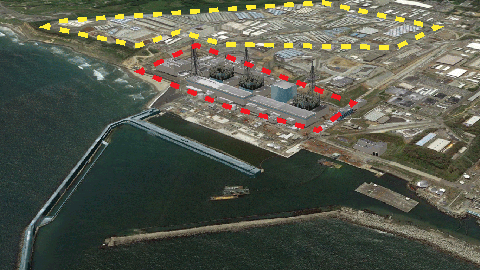Continuous leaking of radioactive strontium and caesium from Fukushima

10/03/2016
11 March marks the fifth anniversary since the nuclear accident at Fukushima. Its nuclear power plant Dai-ichi, severely damaged in the Tohoku earthquake and tsunami, spilled radioactive components into the Pacific Ocean in unprecedented amounts. Since then, the company managing the nuclear power plant, Tokyo Electric Power Company (TEPCO), and Japanese authorities focus their efforts on controlling the water flow around the plant and storing the highly radioactive water, used as a coolant for the damaged reactors (nearly 300 m3 per day), and submitting it to a process of partial decontamination.
A new study, recently published in the Environmental Science and Technology journal, uses data on the concentration of 90Sr and 134,137Cs on Japan's coastline since the accident in 2011 until September 2013 and provides a global perspective which includes data published up to June 2015. The study is the continuation of work began by some of the co-authors after the accident in 2011. Together with other researchers from Belgium and Japan, they are currently collaborating in the European project FRAME, led by Dr Pere Masqué, which aims to study the effect of recent leaks from the nuclear power plant to the ocean. FRAME forms part of the European project COMET (https://wiki.ceh.ac.uk/display/COM/COMET-FRAME).
Seawater collected from the sea surface down to 500 m between 1 and 110 km from the plant contained maximum concentrations of 9, 124 and 54 Bq · m-3 of 90Sr, 137Cs and 134Cs, respectively. The highest concentrations are found within 6 km off the power plant and were approximately 9, 100 and 50 times higher, respectively, than pre-Fukushima levels. Before the accident, the main source of these radionuclides was atmospheric deposition due to nuclear bomb testing performed in the 1950s and 1960s. The presence of 134Cs (undetectable before the accident) and the distinct relationship between 90Sr and 137Cs in the samples suggested that FDNPP was leaking 90Sr at a rate of 2.3 -- 8.5 GBq d-1 (giga-Becquerel per day) into the Pacific Ocean in September 2013. Such a leak would be 100-1000 times larger than the amount of 90 transported by rivers from land to ocean. Additional risk is related to the large amounts of water stored in tanks that have frequently leaked in the past. These results are in agreement with TEPCO's monitoring data which show levels of 90Sr and 137Cs up to 10 and 1000 times higher than pre-Fukushima near the discharge channels of the FDNPP until June 2015 (most recent data included in the study). The results of this study suggest the need of a continuous monitoring of radioactive levels in the Pacific Ocean.